List of Nintendo controllers
The following is a list of video game controllers created for Nintendo consoles.
Nintendo Entertainment System

The Nintendo Entertainment System controller is an oblong brick-like design with a simple four button layout. It consists of two round buttons labeled "A" and "B", a "START" button, and a "SELECT" button.[1] Additionally, the controllers utilized the cross-shaped joypad, designed to replace bulkier joysticks used in earlier gaming consoles’ controllers.[2] The NES controller could also be unplugged as the NES featured two custom 7-pin ports on the front of the console.
Super Nintendo Entertainment System
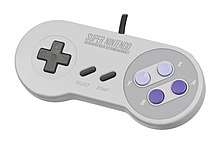
The controller used for the SNES introduces two face buttons X and Y. The four face buttons on the right side are arranged in a diamond shape. Two shoulder buttons are also added and is more ergonomic over the NES controller. The controller was designed by Lance Barr.[3][4] The Japanese and PAL region versions incorporate the colors of the four action buttons into the system's logo. The North American version's buttons are colored as follows: the X and Y buttons are lavender with concave faces, and the A and B buttons are purple with convex faces. Several later consoles derive elements of their controller design from the SNES, including the PlayStation, Dreamcast, Xbox, and Wii Classic Controller.[5][6]
Nintendo 64
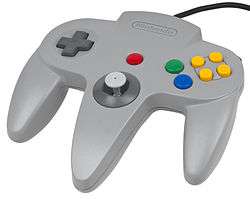
The Nintendo 64 controller is Nintendo's fifth generation controller and features ten buttons, an analog control stick, and a directional pad. The controller is in the shape of an "M", and was designed to be held in three different positions. First, it can be held by the two outer grips, allowing use of the D-pad, right-hand face buttons and the "L" and "R" shoulder buttons (but not the "Z" trigger or analog stick).[7][8] It can be also held by the center and right-hand grip, allowing the use of the single control stick, the right hand-buttons, the "R" shoulder button, and the "Z" trigger on the rear (but not the "L" shoulder button or D-pad).[7] Finally, the controller can be held by the center and left-hand grip, allowing for a combination of the D-pad, L-shoulder, analog stick and Z button.[7]
The design is versatile, but it is also controversial because a player is unable to access all the buttons with the player's hands in any one position. Accessing all buttons would require the player to switch hand positions. The controller also includes four "C buttons" on the top, which were originally intended to control the camera in the N64's three-dimensional environments.[9] However, since the pad only contains three other face buttons, the C-buttons often became assigned to ulterior functions.
GameCube
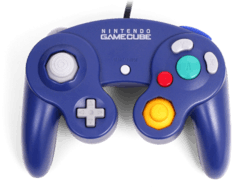
The GameCube controller is Nintendo's sixth generation controller, released along with the GameCube in 2001. The standard GameCube controller has a wing grip design and features a total of six digital buttons, two analog sticks, a d-pad and two hybrid analog triggers/digital buttons.
The primary analog stick is on the left, with the D-pad below it. The four main face buttons are to the right of the controller. The face buttons include a large green "A" button in the center, a smaller red "B" button to its bottom left and the kidney-shaped "X" and "Y" buttons to the right and top of the "A" button, respectively. There is also a yellow "C" stick below the main face buttons. A Start/Pause button is located in the middle of the controller. On the shoulders of the controller there are two analog triggers marked "L" and "R," as well as a "Z" button above the "R" trigger.
The standard GameCube controller provides haptic feedback by way of a built-in rumble motor rather than using an external Rumble Pak add-on like the Nintendo 64 controller.
Wii
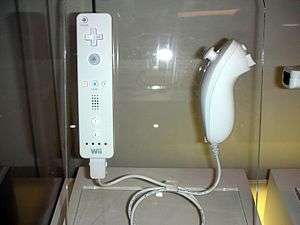
The Wii Remote ditches the traditional gamepad controllers of previous gaming consoles for a one-handed remote control-based design. This was done to make motion sensitivity more intuitive, as a remote design is more optimal for pointing. Another goal with this design was to help the Wii appeal to a broader, non-gamer audience. The body of the Wii Remote measures 6.2 in (160 mm) long, 36.2 mm (1.43 in) wide, and 30.8 mm (1.21 in) thick. The controller communicates wirelessly with the console via short-range Bluetooth radio, with which it is possible to operate up to four controllers as far as 10 meters[10] (approx. 30 ft[11]) away from the console. However, to utilize pointer functionality, the Wii Remote must be used within five meters (approx. 16 ft) of the Sensor Bar.[12] The controller's symmetrical design allows it to be used in either hand. The Wii Remote can also be turned horizontally and used like a Famicom/NES controller or steering wheel.
The Wii Remote has a large "A" button in the front, and a curved "B" button in the back resembling a trigger. Under the "A" button is a plus and minus, and at the bottom of the remote is a "1" and "2" buttons. In the middle of the Wii Remote, between the plus and minus button is a small "home" button that resembling a home/house. There are also blue LEDs indicating player number that are labeled using small Braille-like raised dots instead of Arabic numerals, with "1" being "•", "2" being "••", "3" being "•••", and "4" being "••••".[13]
The blue LEDs also show how much battery power remains on the Wii Remote. By pressing any button, besides the power button while the controller is not being used to play games, a certain number of the four blue LEDs will light up, showing the battery life: four of the LEDs flash when it is at, or near, full power. Three lights flash when it is at 75%, two lights when at 50%, and one light flashes when there is 25% or less power remaining.
The Wii Remote also features an expansion port at the bottom which allows various functional attachments to be added. The most popular attachment is the Wii Nunchuk. It connects to the Wii Remote via a cord that is about 1 to 1.2 m (3.3 to 3.9 ft) long. It features an analog stick similar to the one found on the GameCube controller and two trigger buttons and works in tandem with the main controller in many games.
Wii U
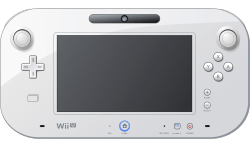
The Wii U GamePad is the standard controller for Nintendo's eighth generation video game console. It incorporates traits from tablet computers and also has traditional input methods, such as buttons, dual analog sticks, and a D-pad. It also features touchscreen and motion controls. The touchscreen can be used to supplement a game by providing second screen functionality or an asymmetric view of a scenario in a game. The screen can also be used to play a game strictly on the GamePad screen, without the use of a television display. Conversely, non-gaming functions can be assigned to it as well, such as using it as a television remote.
Nintendo Switch
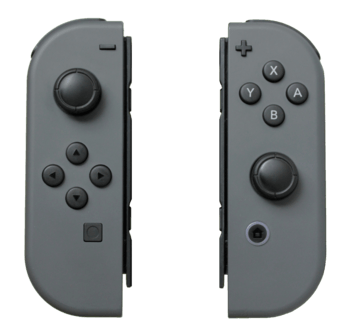
Joy-Con are the primary controller(s) of the Nintendo Switch video game console. They consist of two individual units, each containing an analog stick and an array of buttons. They can be used while attached to the main Nintendo Switch console unit, or detached and used wirelessly. When detached, a pair of Joy-Con can be used by a single player, or divided between two as individual controllers.
References
- ↑ Nintendo Entertainment System Instruction Booklet. Nintendo. 1989. p. 5.
- ↑ Kent, Steven L. (2001). The Ultimate History of Video Games: The Story Behind the Craze that Touched our Lives and Changed the World. Roseville, California: Prima Publishing. p. 279. ISBN 0-7615-3643-4.
- ↑ "Super Nintendo Entertainment System". Nintendo Power. Redmond, Washington: Nintendo of America. 25: 45–46. June 1991.
- ↑ Chad Margetts & M. Noah Ward (May 31, 2005). "Lance Barr Interview". Nintendojo. Retrieved March 2, 2013.
- ↑ Sud Koushik (January 30, 2006). "Evolution of Controllers". Advanced Media Network. Archived from the original on February 7, 2009. Retrieved May 25, 2007.
- ↑ Chris Kohler (September 13, 2005). "Controller's History Dynamite". 1UP.com. p. 4. Archived from the original on September 29, 2012. Retrieved May 25, 2007.
- 1 2 3 "Ultra 64 Controller". Electronic Gaming Monthly. No. 78. Sendai Publishing. January 1996. p. 77.
- ↑ "Get a Grip!!!: Joysticks Past, Present & Future". Next Generation. No. 17. Imagine Media. May 1996. p. 40.
- ↑ "The Ultra 64: Power Packed". GamePro. No. 89. IDG. February 1996. pp. 20–21.
- ↑ "Wii: Technical Details". Nintendo of Europe. Archived from the original on September 4, 2012. Retrieved February 22, 2009.
- ↑ "Nintendo Wii – Hardware Information". Nintendo. Archived from the original on February 12, 2008. Retrieved May 9, 2006.
- ↑ "Wii の概要 コントローラ" (in Japanese). Nintendo Company, Ltd. Archived from the original on July 6, 2006. Retrieved May 9, 2006.
- ↑ Niero (June 14, 2006). "Nintendo Wiimote change: before & after puberty". Destructoid. Archived from the original on February 4, 2007. Retrieved March 19, 2007.